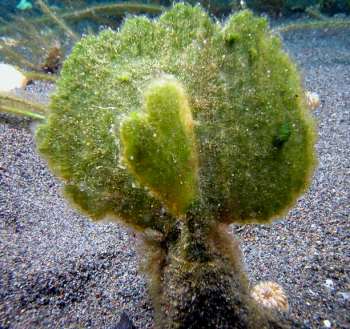
Avrainvillea spp
Phylum: CHLOROPHYTA
Order: BRYOPSIDALES
Family: Udoteaceae
PHOTO
Avrainvillea erecta. Puri Jati - Bali, Indonesia, Indian Ocean. Depth: 5 metres. Length: 5mm. 07 February 2005. Volcanic sand slope - shore dive. Photographer: Ian Dunsmore
Species of Avrainvillea have large paddle-shaped blades, a stalk, and a holdfast to anchor the plant. The stalk and holdfast are developed to different degrees in different species. Some species are solitary, with a single blade, while others consist of clusters of blades. Some species live in sandy sediments and have a large holdfast to anchor them in the sand, while others live on hard substrates, anchoring themselves by wedging their holdfast into cracks and crevices. The blades consist of a long tangled assemblage of fine tubes [or siphons] which are not broken into individual cells. When old blades become covered with other plant and animal growths, the plant is able to abandon the blade - by streaming the protoplasm out of the siphons in the old blade to a new blade. The lack of cell walls make the plant a practical food source for sacoglossan opisthobranchs, which feed by sucking out the cell contents. Avrainvillea is eaten by species of the genus Costasiella.
The species of Avrainvillea illustrated here, A. erecta, is a solitary species found in shallow lagoonal sediments throughout the Indo-West Pacific. The blade can grow to 20 cm across, and the stalk/holdfast can be 10 cm long, but much of it is embedded in the sediment.
Authorship detailsRudman, W.B., 2005 (March 3) Avrainvillea spp. [In] Sea Slug Forum. Australian Museum, Sydney. Available from http://www.seaslugforum.net/factsheet/avrainvillea
